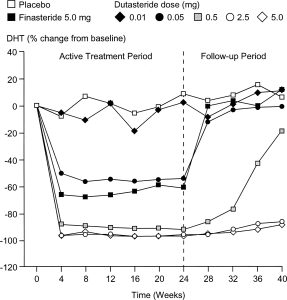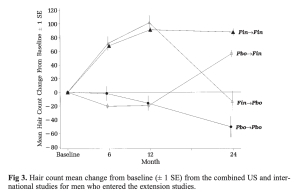So, you’ve decided to stop taking finasteride, and now you’re probably wondering a few things:
- How long does it take for the drug to leave my system?
- When will my hormone levels go back to normal?
- When can I expect my hair loss to kick in again?
Well, the answers aren’t one-size-fits-all, as it depends on how finasteride works in your body. We’re talking about its distribution, saturation, how it binds to tissues, metabolism, and how it gets excreted – all part of the world of pharmacokinetics.
In this article, we’re going to dive into the nitty-gritty of finasteride’s pharmacokinetics. We’ll try to figure out how long this drug keeps doing its thing on the skin of your scalp. And hey, we’ll also spill the beans on a different dosing strategy some finasteride users swear by. They say it helps keep the hair gains while dialing down the risk of side effects. Interested? Let’s get into it!
What Is Finasteride?
Let’s talk about Finasteride, the FDA-approved superhero in the world of hair loss, specifically androgenic alopecia (AGA), which is like the Avengers of hair disorders for adults.
Now, Finasteride is no ordinary drug – it’s got the official stamp of approval. Here’s the lowdown: it puts on its cape and swoops in to block the formation of this sneaky enzyme called 5α-reductase. Why does it care? Because this enzyme is the one turning free testosterone into the troublemaker known as dihydrotestosterone (DHT). And guess what? DHT is the villain behind all the chaos in the hair growth cycle – causing disruptions, thinning, and outright hair loss in AGA.
So, what’s the evidence say? Clinical studies shout from the rooftops that Finasteride is like the superhero we needed. It can lower DHT levels, and in about 80-90% of men who use it, things start looking up for their hair. No wonder many consider it the gold-standard treatment for AGA.
But, and there’s always a but, like any superhero, Finasteride has its kryptonite. Some folks experience side effects. And, sorry ladies, if you’re planning to be pregnant, are already pregnant, or breastfeeding, Finasteride is a no-go. There’s even a debate about whether men should hang up their Finasteride cape before trying to make mini superheroes.
So, what’s the deal? Some Finasteride users decide to part ways with the superhero drug for various reasons. Maybe they’re troubleshooting side effects, planning a family without Finasteride in the mix, or just taking a break because, hey, life happens – whether it’s sidekick troubles or globe-trotting adventures.
What Happens When Someone Quits Finasteride?
Now, let’s talk about what happens when the finasteride rollercoaster takes a pause. Clinical studies are like the crystal ball showing us that once you hit the brakes on this drug, your hair loss journey tends to rewind, bringing you back to where you would’ve been if you never hopped on the finasteride train.
Check out this chart from a two-year clinical study that followed men using 1 mg of finasteride daily. In the group labeled Fin → Pbo, these folks were on the finasteride ride for the first year, thinking everything was peachy. But then, surprise! They switched to the placebo group from year one to year two. And what do we see? Hair counts doing a little victory dance up until year one, only to take a nosedive below the starting line by the end of year two. Talk about a hair-raising plot twist!

Alright, let’s dig into the aftermath of quitting the finasteride party. The folks who make finasteride want to give you the heads-up: once you hit the exit door on the drug, your hair loss is likely to make a comeback. And brace yourself, because any gains you held onto thanks to the drug might bid farewell within 3-12 months.
Now, the burning question: when will the hair loss kick in after you’ve bid farewell to finasteride? The crystal ball on this one is finasteride’s biological half-life in the skin tissues of your scalp. In simpler terms, it’s all about how long finasteride keeps playing superhero, suppressing those pesky DHT levels in your scalp, even after you’ve called it quits with the pills. It’s like the lingering effects of a superhero’s farewell – the real drama unfolds in the biological theater of your scalp
Finasteride’s Impact on DHT Levels in the Scalp
Let’s break it down: DHT is the troublemaker linked to hair loss in androgenic alopecia (AGA). Enter Finasteride, the hero in this story, capable of slashing DHT levels by approximately 70% throughout your body. With this kind of suppression, AGA often hits the brakes, and you might even witness some hair regrowth – a victory for the good guys.
But, here’s the twist: when it comes to regrowing the crown jewels of your hair kingdom, DHT reduction is crucial, especially in the scalp. Forget the body – we’re talking about the battleground where balding scalps wage war.
Now, here’s a blast from the past: studies from the 1980s and 1990s spill the beans that up to 80% of the DHT causing trouble in balding scalps is locally produced right there at the hair follicle site – think the outer root sheath, dermal papillae cell cluster, and even the mesodermal sheath.
So, when the million-dollar question pops up – “How long does finasteride hang out in the bloodstream?” – it might be a bit off the mark. The real head-scratcher is this: “How long does finasteride keep throwing punches at scalp DHT levels, even after you’ve called it quits with the drug?” That’s the mystery we’re trying to solve in the hair-loss saga.
Now, let’s unravel the mystery of how long finasteride keeps its superhero cape on in your scalp. The key players in this drama are:
- Terminal Half-Life: This is the countdown to when 50% of the finasteride you swallowed bids farewell. It’s like a ticking clock until it’s metabolized and makes its way to the digestive tract for a grand exit.
- Tissue Dissociation: Picture this as the finasteride superhero unbinding itself from tissues. It’s like the superhero deciding it’s time to leave the scene and either hopping back into circulation or heading off to the digestive tract for its final curtain call.
- Biological Half-Life: Now, combine the terminal half-life and tissue dissociation timing. This is the grand finale – the moment when 50% of the drug says, “Okay, my work here is done.” Translation: when does finasteride stop its biological magic, specifically in lowering those pesky DHT levels?
What Duration Does Finasteride Affect DHT Levels on the Scalp?
- Terminal Half-Life: It’s a swift 5-7 hours, but here’s the plot twist – it stretches a bit in the older audience, taking a tad longer.
- Tissue Dissociation: This is where it gets interesting. Picture finasteride as a persistent hero – it hangs around for 4-5 days, attaching itself to organs like a sidekick that won’t leave the stage. This lingering attachment means the drug might have a longer-lasting impact than you’d expect from its terminal half-life alone.
- Biological Half-Life: Brace yourself for the big reveal. Thanks to its tissue dissociation dance, the biological half-life stretches out to 14-30 days. Imagine a superhero who, after a few rounds of 1 mg daily ingestions, reaches peak distribution and saturation throughout the body. That’s when the real show begins, and the impact lingers for a good while.

- Alright, let’s shine a spotlight on the lingering impact of finasteride on scalp DHT levels. Brace yourself for the revelation: even after bidding adieu to the medication, finasteride seems to have a lasting effect, appreciably lowering scalp DHT levels for most individuals for up to a solid 30 days.
- Picture this in action: a clinical study steps into the scene, measuring blood DHT levels in a finasteride and dutasteride versus placebo showdown. The results were like a mic drop moment, showcasing how the influence of finasteride lingers beyond its active usage.
- So, for those wondering about the aftermath of quitting finasteride, this study spills the beans – the impact echoes for a good 30 days, making it a crucial chapter in the saga of how long finasteride continues to sway the scalp’s DHT dance.
Now, let’s unravel the mystery of why finasteride continues to leave its mark, especially in the skin. Picture this: finasteride gets cozy with cells within the skin, and studies spill the beans that it has a nifty trick up its sleeve – a tissue dissociation timing of 4-5 days.
Here’s the play-by-play: once finasteride snuggles up to skin cells, it takes a 4-5 day breather before deciding to part ways. It’s like a superhero bidding farewell to its host tissues, making a grand reentry into the bloodstream for its final act – metabolism and excretion.
Now, here’s the twist in the tale: armed with this knowledge of finasteride’s pharmacokinetics, users can actually turn the tables to their advantage. It’s like understanding the superhero’s secret moves. Users can strategically hit pause on finasteride (if needed) while still keeping a firm grip on those precious hair gains. It’s like having the best of both worlds in the finasteride playbook.
Utilizing the Timing of Finasteride’s Tissue Dissociation to Your Benefit
Let’s dive into the intriguing world of temporarily parting ways with finasteride without bidding farewell to your precious hair gains. Many users have pondered, “Can I take a break from the drug without sacrificing my progress?” The answer, according to the script of clinical studies, seems to be a promising yes – at least for short cessation periods.
In a noteworthy clinical study with men, the plot twist was a 30-day on, 30-day off dosing schedule for the second year. The result? Comparable hair regrowth to those who stuck to the daily finasteride routine. Essentially, these men slashed their drug exposure by 50% in year two, enjoying a total of 6 months off the drug without waving goodbye to their hair gains.
This magic trick is all thanks to finasteride’s biological half-life, playing a pivotal role connected to its terminal half-life and tissue dissociation timings.
And here’s the real-life superhero testimony – many folks in our community have tried taking a 2- to 3-week breather from finasteride. Whether it’s troubleshooting side effects or fully unplugging during family vacations, they report no adverse impact on their hair gains. It’s like a harmony between clinical evidence and real-world experiences in our community.
But, before you embark on your finasteride dosing experiments, here’s the cautionary note: once you cross the month mark of quitting, scalp DHT levels are likely to fully return to baseline, and the hair loss symphony resumes. So, it’s a balancing act, and it’s essential to tread carefully when toying with different finasteride dosing schedules.
